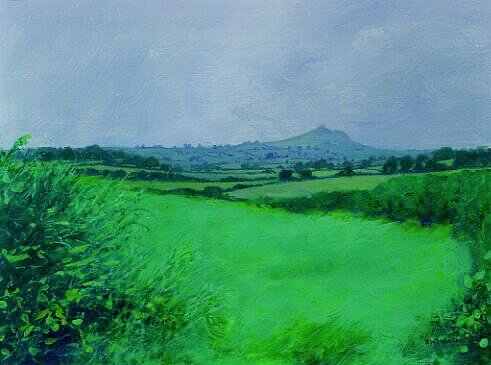Steeple Chasing - Landscapes 1985 - 1990
From 1972 to 1985 Mountjoy earned a living by teaching art in Cheltenham, Gloucestershire. A frequent and often successful lesson involved ‘Steeple-Chasing’. If the day was warm and dry, he would collect clipboards, paper and pencils and take his class out onto the Hester’s Way Estate. From the top floor of the school, St Peter’s Church on the Tewkesbury Road could be seen and the teacher and pupils set out to find and draw different views of this modest landmark.
The intention was to find glimpses of St Peter’s between the streets and to draw the context. Mountjoy admits the idea was not his, but developed from Eileen Adams’s “Art and the Built Environment Project”. Adams had gained fame for her pioneering art teaching in London.
Back in the classroom he asked the students to use their drawings as a structure upon which to they could create a sense of place. (A Walk Along Bramley Road). They ‘worked up’ their drawings, converted some to paintings and developed others as ‘constructions’.
Please scroll down to view the paintings
Brentor from Southerly Down, 1988, Acylic on Board, 25 X 20 CMS
In 1985 he found himself at a new comprehensive in Plymouth, Devon, and with a new home on the western slopes of the Dartmoor National Park.
The move interrupted his painting and when he started again; he painted landscapes. His abstract thread had broken and in hindsight, he acknowledges it was a way of reacquainting with his home county. “I did my own ‘steeple-chasing’ project, wandering around the Devon lanes finding different views of Brentor.” The hill is a small carboniferous basaltic undersea volcano, but now raised and eroded, it stands proud on the edge of the Tamar valley, crowned by a small stone church. Mountjoy produced a series of small acrylic paintings from his studies.
At the same time as he was painting Brentor, he took up his late father’s family history project and set out to find the places where his Cornish/Devonian ancestors had lived. On one occasion he was disappointed to find that the family home had vanished; the thatched roof had rotted, with no funds for repair rain soon eroded the cob walls. Once the stone foundations had been robbed out all that remained was a patch of rough ground. His interest in the breakdown of man’s constructs and natural reclamation emerged once again.
Most paintings from the series were sold at the 1999 Tavistock Exhibition but some remain with the artist. The collection has been supplemented by more small paintings that have been reworked from those drawings he made during stops on cycling expeditions around the Western edge of Dartmoor.









